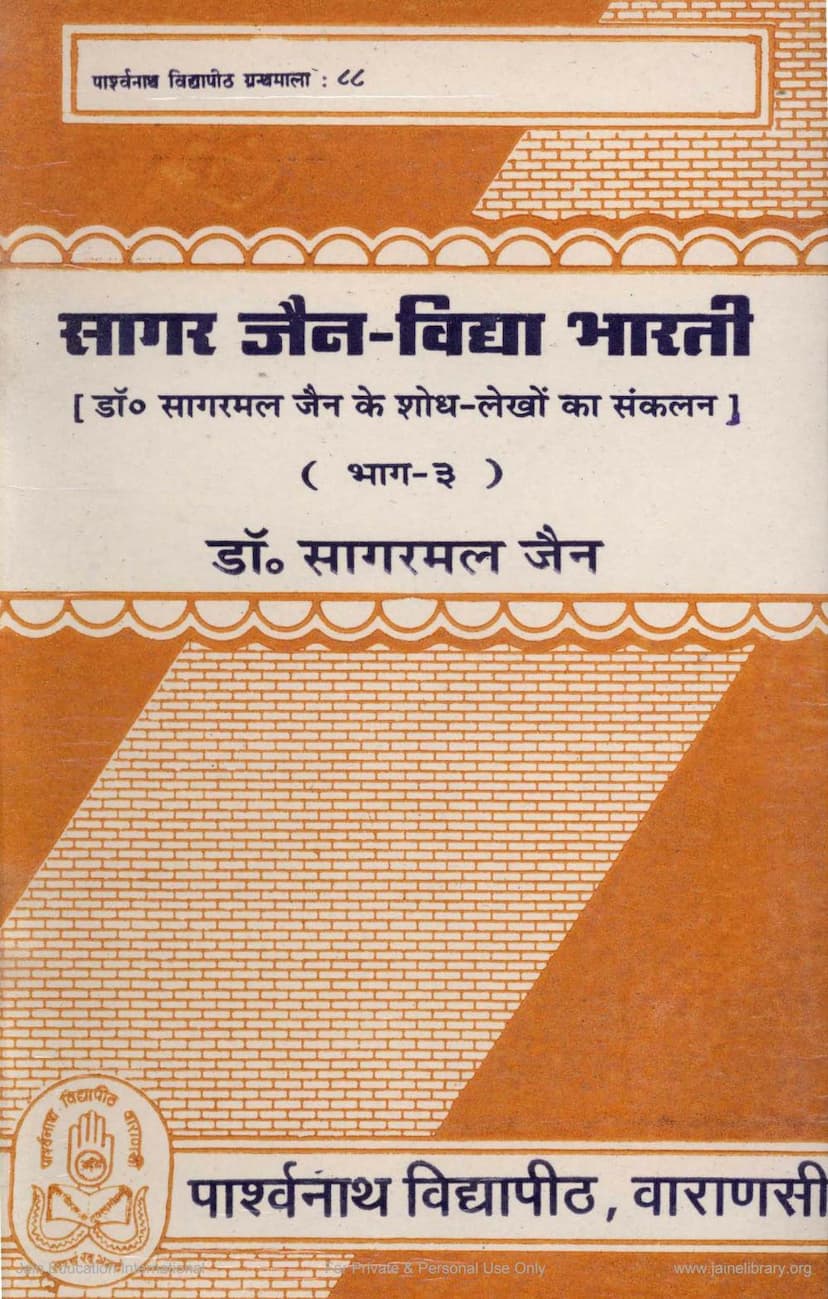Sagar Jain Vidya Bharti Part 3
Added to library: September 2, 2025

Summary
The document is the third volume of "Sagar Jain-Vidya Bharti," a collection of research articles by Dr. Sagarmal Jain, published by Parshvanath Shodhpith, Varanasi, in 1997. The book is part of the Parshvanath Vidyapith Granthamala series.
The volume contains a compilation of Dr. Sagarmal Jain's published and unpublished articles covering various aspects of Jainism, philosophy, history, literature, and science. The table of contents reveals the following essays:
-
Jainism and Social Thought (जैनधर्म में सामाजिक चिन्तन): Discusses Jainism's perspective on social thinking, contrasting it with Vedic and Upanishadic periods. It highlights Jainism's emphasis on universal welfare and the concept of 'samata' (equanimity) as the basis for social consciousness and non-violence. It also explores the individual-society relationship from a Jain viewpoint, the role of ego, and the basis of sociality in conscience rather than attachment.
-
Spirituality and Science (अध्यात्म और विज्ञान): Examines the apparent conflict between spirituality and modern science, arguing that they are not opposing forces but rather complementary. It suggests a need for their integration for human welfare, with spirituality providing the goal and science the means.
-
Mutual Influence of Jain, Buddhist, and Hindu Religions (जैन, बौद्ध और हिन्दू धर्म का पारस्परिक प्रभाव): Analyzes the historical interaction and mutual influences between these major Indian religious traditions, tracing the development of concepts like renunciation, karma, and deities across these traditions.
-
Acharya Hemachandra: A Man of the Era (आचार्य हेमचन्द्र : एक युगपुरुष): A biographical and analytical study of the influential Jain scholar-monk Acharya Hemachandra, highlighting his contributions to literature, politics, and religious tolerance.
-
Emperor Akbar and Jainism (सम्राट अकबर और जैन धर्म): Explores the relationship between Emperor Akbar and Jainism, particularly the influence of Jain scholars like Hiravijaya Suri on Akbar's policies of religious tolerance, animal welfare, and vegetarianism.
-
The Question of Acelakatva and Sacelatva in Jainism (जैनधर्म में अचेलकत्व और सचेलकत्व का प्रश्न): Delves into the historical debate within Jainism regarding the practice of nudity (acelakatva) versus being clothed (sacelatva) for monks, tracing its origins and interpretations within different sects.
-
The Question of Women's Liberation, Liberation of Other Faiths, and Liberation while Clothed (स्त्रीमुक्ति, अन्यतैर्थिकमुक्ति एवं सवस्त्रमुक्ति का प्रश्न): Addresses the complex issues of liberation for women, followers of other faiths, and those who remain clothed, examining the differing perspectives within Jain traditions.
-
Contribution of Pramana-Mimamsa in Pramana-Lakshana-Nirupana (प्रमाण-लक्षण-निरूपण में प्रमाणमीमांसा का अवदान): Analyzes the philosophical contributions of Jain epistemology, particularly highlighting Acharya Hemachandra's "Pramana-Mimamsa" and its approach to defining valid knowledge.
-
Review of "Shad-darshan-samuccaya" Edited and Translated by Pt. Mahendra Kumar 'Nyayacharya' (पं० महेन्द्र कुमार 'न्यायाचार्य' द्वारा सम्पादित एवं अनूदित षड्दर्शनसमुच्चय की समीक्षा): A critical review of a significant work that compiles and translates various Indian philosophical schools, praising the translator's clarity and scholarly approach.
-
Place, Importance, Period of Composition, and Author of Prakirnakas in Agam Literature (आगम साहित्य में प्रकीर्णकों का स्थान, महत्त्व, रचना-काल एवं रचयिता): An academic study of the "Prakirnakas," a category of Jain scriptures, discussing their place, significance, dating, and authorship within the broader Agam literature.
-
Spiritual Development in Jainism (जैनधर्म में आध्यात्मिक विकास): Explains the Jain concept of spiritual progress through stages, categorizing the soul into Bahir-atma (external self), Antar-atma (internal self), and Param-atma (supreme self).
-
The Principles of Mahavir Swami in the Context of His Era (युगीन परिवेश में महावीर स्वामी के सिद्धान्त): Examines the relevance of Lord Mahavir's teachings in addressing contemporary issues like mental conflict, social strife, ideological clashes, and economic inequality.
-
Jainism and Modern Science (जैनधर्म और आधुनिक विज्ञान): Discusses the compatibility and areas of convergence between Jain philosophical concepts and modern scientific discoveries, particularly in cosmology, biology, and ethics.
-
Mutual Relationship between Jainism and Hinduism (Sanatan Dharma) (जैनधर्म और हिन्दूधर्म ( सनातन धर्म) का पारस्परिक सम्बन्ध): Analyzes the historical and philosophical connections and influences between Jainism and Hinduism, emphasizing their shared roots and syncretic development within Indian culture.
-
Shaiva-Mula-Sangha and Mathura-Sangha: A Discussion (श्वेताम्बर मूलसंघ एवं माथुरसंघ : एक विमर्श): Investigates the historical evidence of "Mul-Sangha" and "Mathura-Sangha" within the Shvetambara tradition, challenging conventional assumptions and presenting new epigraphic findings.
-
Classification of Trasa and Sthavara Jivas in Shat-Jivanikaya: A Problem (षड्जीवनिकाय में त्रस और स्थावर के वर्गीकरण की समस्या): A detailed analysis of the classification of living beings in Jainism into 'trasa' (moving) and 'sthavara' (immobile) categories, examining discrepancies and interpretations within ancient Jain texts.
-
Rishibhashita: A Study (ऋषिभाषित : एक अध्ययन): An in-depth study of "Rishibhashita," an ancient Jain Prakrit text containing teachings of various ascetics, analyzing its language, historical context, and theological content.
The publication aims to provide scholars and general readers with a comprehensive understanding of Jainism's rich intellectual tradition.